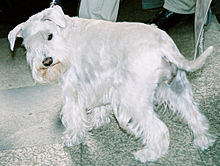Miniature Schnauzer: Difference between revisions
| Line 31: | Line 31: | ||
Height is 12 to 15 inches (30.5 to 38 cm) at the [[withers]], and they generally weigh 10 to 15 pounds (4.5 to 7 kg). |
Height is 12 to 15 inches (30.5 to 38 cm) at the [[withers]], and they generally weigh 10 to 15 pounds (4.5 to 7 kg). |
||
==Temperament== |
==Temperament== |
||
Revision as of 02:05, 11 February 2007
| Miniature Schnauzer | |||||||||
|---|---|---|---|---|---|---|---|---|---|
| File:Miniature-Schnauzer4.jpg Miniature Schnauzer with salt and pepper coat. | |||||||||
| Other names | Zwergschnauzer | ||||||||
| Origin | Germany | ||||||||
| |||||||||
| Dog (domestic dog) | |||||||||
The Miniature Schnauzer is a breed of small dog of the Schnauzer type that originated in Germany in the mid-to-late 19th century. Miniature Schnauzers developed from crosses between the Standard Schnauzer and one or more smaller breeds such as the Poodle, Miniature Pinscher, or Affenpinscher.
Appearance

Miniature Schnauzers are quite distinctive in appearance. They should be compact, muscular, and be "square" in build (the height at the withers should be the same as the length of the body). They have long beards, eyebrows, and feathering on the legs. Ears are sometimes cropped to stand upright, and the tail is often docked short. Their coats are wiry (when hand-stripped,) and do not shed, which adds to their appeal as house pets. Miniature Schnauzers are highly recommended for dog owners who suffer from asthma. However, their coats have to be clipped every three months, as they do not shed. The AKC recognizes only three colours: black, salt and pepper, and black and silver. However, non-official colours of solid white and brown are rare but known.
Height is 12 to 15 inches (30.5 to 38 cm) at the withers, and they generally weigh 10 to 15 pounds (4.5 to 7 kg).
Temperament
Miniature Schnauzers are known for their lively personality and mischievous sense of humour. They are also highly loyal to their owner and can be very energetic, but if not given proper excercise or a balanced diet, they will gain weight very quickly.
An excellent protector of his home, the Miniature Schnauzer is often guarded of strangers until the owners of the home welcome the guest. The breed is very good with children recognizing that they are needing gentle play.
Because a Miniature Schnauzer can take commands and learn quickly, they are easy to train. However, Miniature Schnauzer's require a great deal of attention and affection from their owner, regardless if they are to be used as show dogs or home pets.
History
The earliest records surrounding development of the Miniature Schnauzer in Germany come from the late 1800s. In the breed's earliest stages, several small breeds were employed in crosses to bring down the size of the well-established Standard Schnauzer, with the goal of creating a duplicate in miniature.
Crossing to other breeds, such as the Affenpinscher and Miniature Pinscher, had the side effect of introducing colours that were not considered acceptable to the ultimate goal — and as breeders worked towards the stabilization of the gene pool, mismarked particolors and white puppies were removed from breeding programs.
As puppy mills commonly trade breeding stock back and forth, the gene is introduced into other mills (in exchange with Fox Terrier or Poodle infused particolors, etc.) and so the white gene becomes firmly established in that population. Commercial breeders sell to pet stores, and these form the genetic basis of the vast majority of "backyard breeder" dogs. As none of these animals are bred for the show ring, the fact that they do not exhibit quality in type is irrelevant. Crossbred animals would have very great difficulty surviving in the show-breeding gene pool — they would find it difficult to win or produce offspring who could.

It does not however, lend any credibility to the argument that white schnauzers are purebred and should be perpetuated as such.

The earliest recorded Miniature Schnauzer was in 1888, and the first exhibition was in 1899. With their bold courage, the Miniature Schnauzer was originally used for guarding herds, small farms, and families. As time passed, they were also used to hunt rats, because they appeared to have a knack for it, and its small size was perfect to get into tight places to catch them. The AKC accepted registration of the new breed in 1926, two years after they were introduced to the United States.
Health
Miniature Schnauzers are prone to diabetes, bladder stones and pancreatitis. With proper care, without feeding the dog sweet or fattening food, it can often be avoided. Miniature Schnauzers with uncropped ears are prone to ear infections and deafness later in life if the ears are not checked regularly or dried out after swimming. Perfect weight varies on what size the dog is; if the dog is 14 inches high, and then the perfect weight would be 14 lbs. They should not be overfed since they gain weight easily. They can also develop a type of skin allergy, which shows up as a 'hot spot' often around the neck area, which can be tender for the animal forming a hard crust after weeping.
External links
- Miniature Schnauzer Club of Canada
- American Miniature Schnauzer Club
- Schnauzer Club of Britain
- Estonian Schnauzer Club
- Schnauzer Club of Victoria
- Schnauzerclub of The Netherlands
See also
